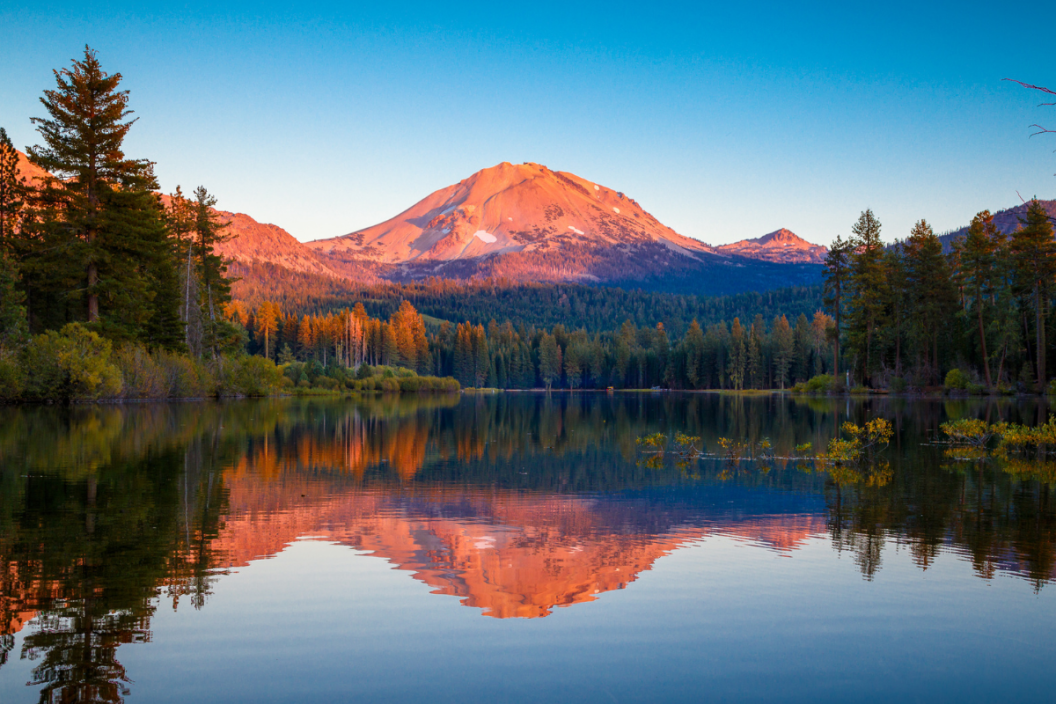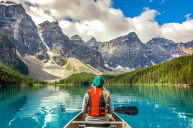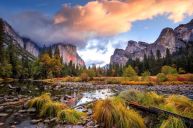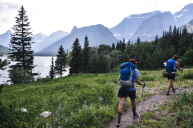California is the third-largest state by land area in the United States. "The Golden State" lays claim to the Golden Gate Bridge, Muscle Beach in Santa Monica, more than 18 professional sports teams, and Yosemite National Park. Travelers are hard-pressed to find an empty block of time adventuring up and down the Golden Coast.
Often forgotten, as the spotlight naturally drifts towards Hollywood and the allure of the Pacific, are the other natural wonders found in California. Massive redwoods tower over the Northwest, while the Mojave Desert envelops the Southeast. Meanwhile, the Sierra Nevada and Cascade Ranges protect the state's north and eastern borders. It's here, in Lassen Volcanic National Park, where the largest plug dome volcano in the world towers over the region, helping to create a completely new landscape over the last few thousand years.
Where Is Lassen Volcanic National Park?
Tucked in northern California, Lassen National Park is an area of active boiling mud pots, fumaroles and hot springs; Volcanic activity here is caused by the Gorda Plate slowly moving below the North American Plate off of California's coast. (For the science nerds like me, this process is called subduction.)
Lassen Peak and Cinder Cone Volcanoes
The big-ticket item of the area is Lassen Peak, which is considered the largest plug dome volcano in the world. Don't worry: it's been over 100 years since Lassen Peak last erupted back in May 1914 (eruptions that continued for three years), breaking what's believed to have been a 27,000-year "slumber" for the volcano.
Cinder Cone is another volcano here, located about 10 miles from Lassen Peak, which last erupted about 350 years ago. Cinder Cone's name mirrors the type of volcano it is; this area is one of few in the world where all four major types of volcanos can be found, including shield, composite, cinder cone and plug dome volcanoes.
The Painted Dunes and Fantastic Lava Beds left behind by eruptions of the past are just some of the spectacular views found by adventures traveling to the park.
What To Do at Lassen Volcanic National Park
https://www.instagram.com/p/CIGI6s-sIB0/
The Manzanita Lake campground offers 179 sites for tent camping, including a few dozen cabins and room for RVs and trailers. Coin-operated showers, laundry, kayak rentals, and a camper store leave nothing up to chance. Of course, swimming and boating are welcome at the lake during the summer months. Juniper Lake and Butte Lake also highlight the backcountry's natural beauty.
Looking for a more structured stay? Check out Drakesbad Guest Ranch, which is considered one of California's best places to visit.
There are miles of hiking trails across the national park as well, which wind through wildflower meadows and Warner Valley to the south, an area marked by hot springs like Devils Kitchen and Terminal Geyser. In the southwest area of the park, Sulphur Works near Brokeoff Mountain marks one of many hydrothermal areas here, where hot water temperatures can surpass 200 degrees Fahrenheit.
Near Little Hot Springs Valley is Bumpass Hell Trail, a geothermal area that's one of the region's most popular hikes. The area is named for Kendall Vanhook Bumpass, but his story isn't exactly one of great memories:
"Our guide, Mr. Bumpass, after cautioning us to be careful where we stepped ... broke through the crust and plunged his leg into the boiling mud beneath."
— Watson Chalmers, Red Bluff Independent, 1865 (h/t, National Park Service)
Due to the 8,000-foot-high elevation here, it's not uncommon for more than 30 feet of snowfall to cover Main Park Road and park trails during the winter and all the way into June, which causes openings, like the Bumpass Hell trailhead, to fluctuate year to year. From 2011 through 2017, that trail's opening date ranged from June 11 all the way to August 22. (The trail was closed starting in 2018 through September 13, 2019 for a rehabilitation project.) Once opened, hiking here is welcome through October until snow returns to the area.
But snow doesn't mean the fun stops! If exploring steam vents and a once-active volcano isn't your thing, snowshoeing through various trails is open, especially around Lake Helen where annual snowfall is around 600 to 700 inches. Once the highway is closed for the winter, though, park access is only available at the Kohm Yah-mah-nee Visitor Center (southwest entrance) and Loomis Plaza (northwest entrance).
Visit www.nps.gov for more park info related to the ongoing COVID-19 crisis.
Ever explored an active volcano? Share your story at our Wide Open Roads Facebook!




